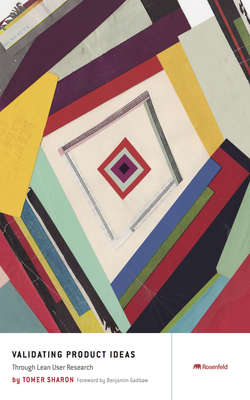Читать книгу Validating Product Ideas - Tomer Sharon - Страница 38
На сайте Литреса книга снята с продажи.
STEP 1: Create BS personas.
ОглавлениеGather your team, grab a sticky pad, whiteboard, or flip chart and bullshit your way into a couple of personas. A persona is an archetypical user of your product or service. Each product might have several personas. For example, an app for grocery shopping might have the following personas:
• The soccer mom
• The clueless male student
• The bored toddler
• And more...
Developing product personas is great for improving communication between different product development practitioners in your organization by creating a common language to describe groups of product users. Personas can help teams make product roadmap decisions. That said, personas will not help you decide if a button should say “Buy now” or “Pay now” or whether it should be green or blue.
A bullshit persona is a persona that is based on guesses (educated or not) and assumptions, rather than actual research and factual data. Sadly, many people stop after creating bullshit personas, thinking that by doing that they “are doing UX” or checking the box for research. To be clear, a persona (real or assumptive) is not a user research methodology. Rather, it’s a communication tool.
The power of the bullshit persona is that it helps you and your team focus your research, validate or invalidate your assumptions, and lead you to developing a real, research-based, valid, and reliable (no bullshit) persona.
Together with your team, ask yourselves the following questions and identify which aspects of your audience you are less sure of or familiar with.
1 How would you describe your target users? What are their primary characteristics?
2 Are there different groups of users?
3 How are user groups different?
4 Is there a particular group that is more important than the other ones?
5 Is there a particular group that you want to learn more about? Why?
6 Who are (or would be) the early adopters of your product? What are their characteristics?
The best way to answer these questions is by listing your assumptions about the answers. Recognizing your answers as assumptions, not as facts, is a great early step toward a successful lean user research study. By the end of your research, you will validate or most likely invalidate these assumptions, as well as have a clearer idea of who your users are.
If you feel that some of the questions are similar to one another, it is not a mistake. Asking the same question in different ways will help you exhaust all of your team’s assumptions about your users. Some of the things you and your team might have as objectives could be to find out more about the goals, tasks, pain points, behaviors, experiences, and attitudes (including concerns) that are important to each user group.
As you are answering the previous questions with your team, bullshitting your way into a persona or two becomes easy:
1 Draw a large rectangle and divide it into four (see Figure 2.4).
2 Give each part a title: [Persona name], Demographics, Problems, and Solutions (see Figure 2.5).
3 In the first part, sketch the face of the persona. Don’t worry about not creating a Da Vinci (see Figure 2.6).
4 In the second part, brainstorm and list a few bullet points to indicate some demographic data about the persona, such as age, occupation, marital status, kids, education, income, etc.
5 In the third part, brainstorm and list a few bullet points to indicate key problems you guess the persona has regarding the domain you are interested in.
6 In the fourth part, list a few ideas for features or products that will hopefully solve the persona’s problems you listed earlier (see Figure 2.7).
7 Repeat steps 1–6 for additional bullshit personas. You can potentially have as many as 12 personas, but don’t overdo it. A handful of personas is probably enough bullshitting at this point.
FIGURE 2.4 Rectangle divided into four.
FIGURE 2.5 BS persona template.
FIGURE 2.6 Not a Da Vinci.
FIGURE 2.7 Complete BS persona.
